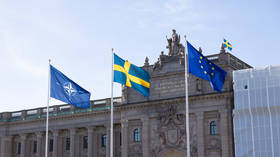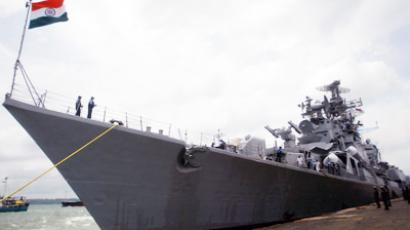India’s new flagship: Russia hands over modernized aircraft carrier to New Delhi
The Indian Navy has received the 44,500-ton Vikramaditya aircraft carrier at the Russian shipbuilding complex in Severodvinsk. The much awaited carrier was fully refurbished for US$2.3 billion, and will now become India’s game-changing flagship.
Russian deputy Prime Minister Dmitry Rogozin and Indian Defense
Minister AK Antony attended the handing over ceremony at the
Sevmash shipyard of the northern Arctic port city, along with
other senior government and naval officials of the two countries.
During the ceremony, a Russian flag on the vessel was lowered,
and the flag of the Indian Navy was raised in its place. This was
followed by a traditional Indian ritual, in which a coconut was
smashed against the ship’s side. The ship’s new captain, Suraj
Berry, and the deputy director of Russia’s arms export agency
Rosoboronexport, Igor Sevastyanov, signed the final handover
papers.
Rogozin called the carrier “a mighty contribution to security
of India,” adding that India remains a privileged strategic
partner of Russia. The ceremony comes just two days ahead of the
meeting of the Indo-Russian Inter-Governmental Commission on
military-technical cooperation.

Originally commissioned in 1987 as a Soviet Kiev-class aircraft
carrier, the ship was deemed too costly for the Russian military
budget and was deactivated in 1996. The aircraft carrier - then
called ‘Admiral Gorshkov’ - caught India’s attention, and,
following years of talks, a Russian-Indian deal for the ship was
signed.
In order to match the demands of the Indian Navy, the carrier had
to be fully modernized and converted from a hybrid
carrier/cruiser to a pure carrier with a ski-jump ramp to fit
multirole MiG-29K (Fulcrum-D) fighters.
The refurbishment work, which eventually saw over 70 percent of
the ship and equipment replaced, was overshadowed by several
delays and cost increases, leading to a diplomatic exchange and
tightening of supervision. It became apparent in the process that
the Russian shipbuilders underestimated the cabling work costs,
and the initial $974 million price tag grew to about $2.35
billion. Some construction flaws also had to be fixed following
the 2012 tests.
The purchase of INS Vikramaditya has been crucial for the Indian
Navy, as its British-made INS Viraat, originally commissioned by
the UK’s Royal Navy in 1959 as HMS Hermes, has been scheduled for
retirement. India’s first indigenous Vikrant-class aircraft
carrier has also been experiencing delays. It was launched two years behind schedule in August, with
the expected service entry date being 2018.
Now that Vikramaditya is set to be escorted from Russia’s north
to the Indian Ocean, India becomes one of the few nations in the
world to have more than one aircraft carrier in service - the
others being the US, the UK, and Italy. With two ships of that
class, India will have the capability to promptly project force
on both sides of the Hindustan Peninsula in the increasingly
militarized region. Previously, India’s retired carrier INS
Vikrant played a key role in enforcing the naval blockade on East
Pakistan during the Indo-Pakistan War of 1971.

As for Russia, which currently has one aircraft carrier (Admiral
Kuznetsov), it has “no need for [another] ship of the same
class,” Rogozin said on Saturday. Calling the fact of having
more aircraft carriers “a geopolitical issue,” the Russian
deputy prime minister stressed it is “not the issue of the
country’s defense capability.” Meanwhile, Russia awaits the
delivery of two Mistral-class helicopter carriers from France.
The new Indian flagship was redesigned by Russian shipbuilders to
carry 16 MiG-29K fighters and up to 10 Ka-27 and Ka-31 helicopter
gunships. With the ship’s length being 284 meters and her beam
nearly 60 meters, INS Vikramaditya stretches to an area as large
as three football fields and has 22 decks for housing more than
1,600 crew members. It has been estimated that the ship can
operate up to 45 days without replenishment, while having the
capability to cover 1,400 kilometers a day and maintaining a
“surveillance bubble” of a 500 kilometer radius.














